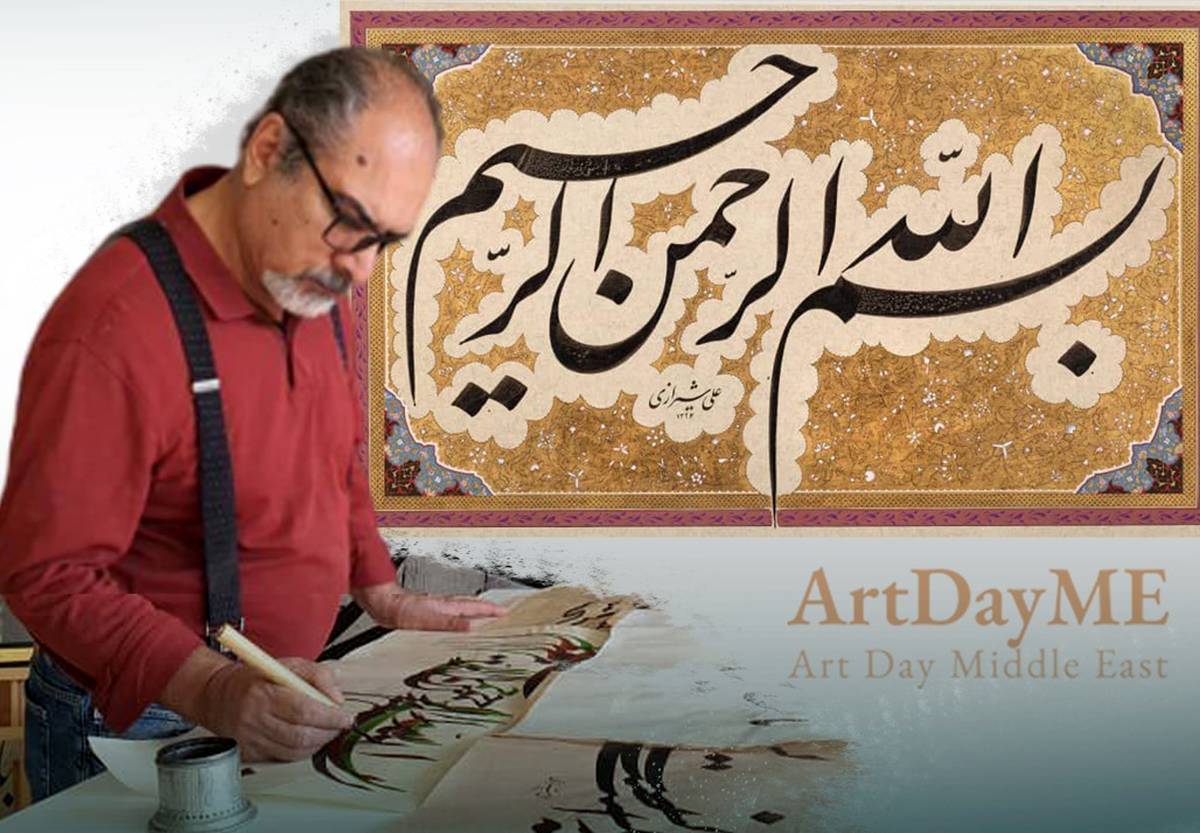
Ali Shirazi and 7 secrets of calligraphy of the "Bismillah ar-Rahman ar-Raheem" with 30 mm pen
Ali Shirazi, a renowned calligrapher in the Middle East, created the calligraphic piece "بسم اللّٰه الرحمن الرحيم" or "Bismillah ar-Rahman ar-Raheem" (In English: "In the Name of Allah, the Most Beneficent, the Most Merciful"). The exceptional calligraphy and the artist's remarkable ability to write continuously are what set this particular work of art apart.
ArtDayMe: Ali Shirazi is a well-known name in classical Iranian and Middle Eastern calligraphy. He has a reputation for his proficiency with big pens, writing without halting, and attention to all the essential rules of this old art.
An examination of "Bismillah ar-Rahman ar-Raheem" exposes some of its unique characteristics:
1: The harmony, homogeneity, and flow of the entire piece, which are founded in the so-called "writing without halt" by the master calligrapher, are the initial draw of the work and capture the viewer's attention at first glance. It is obvious that the calligrapher performed a calligraphic act while creating this work of art.
Shirazi is regarded by the calligraphy community as being unique from his contemporaries for two reasons: a command of big pens and the capacity to write continuously with it. He sets himself apart from other artists in this field by combining both of those qualities, which is also clear in this work.
2: He used a 30 mm pen to write "Bismillah ar-Rahman ar-Raheem". Professional calligraphers are aware that when the pen size increases, it becomes more and more difficult to follow the well-established and essential standards and laws of authentic calligraphy.
Because of this, some people liken writing continuously with large pens to pulling weights in a single motion. The difficulty increases with the weight!
It can be compared to reading the Quran or singing a song to write continuously with a huge pen while fusing knowledge and experience. A Quran reader or singer is aware of how much air is necessary for each verse so that you do not become out of breath while reading.

3: The writing without halt, the stretching of "Bis" ("بس") at the start of the text, and the placement of "Rahman" ("رحمن ") or "heem" ("حيم") at the conclusion of the sentence are all evident indications of Shirazi's artistic zenith.
One needs to use enough ink and keep a breath in the chest in order to write "Bis" ("بس") in a stretched form. Pressure should be applied to the pen's tip at the very start of writing. The central section of the pen receives the applied pressure next, and the tines of the pen get it last.
It is obvious that the intensity of the pressure and the way it exists call for years of training and expertise. However, experts know that a pen is easier to use when it is smaller and harder to use when it is larger.
Another element that contributes to the amazing impact is the speed of hand motion. To be clear, if the hand's movement is slow, the ink runs out right as you start writing, and you must re-ink to continue. Naturally, a stroke is produced on the paper as a result, and in Shirazi's calligraphic style, writing like this is improper. This calligraphic performance can be compared to the same example of a snatch weight lifter. It is important to write a sentence consistently and without pausing.
Master Shirazi additionally conveys this accomplishment by penning the term "Rahman" ("رحمن") in his writing. The entire aesthetics and composition of the work would be destroyed if the letter "n" ("ن") were written a little bit lower or higher, thinner or thicker, wider or narrower.
4: The audience first sees the letter "B" ("ب") at the bottom of Shirazi's creation before shifting their gaze upward to read till they reach the word "Raheem" ("رحیم"). This upward motion, which is a metaphor for moving from the earth to the sky, is congruent with the meaning and core of the word.
5: Based on the calligraphy's truthfulness, the placement of "illah" ("اللّٰه") and two "ar" ("الر") in the work is crucial since they are situated in the main point and the viewer's field of vision. This contains the overall work's harmonic pulse. The notion is conveyed by the proficient calligrapher, who also adds a pleasing rhythm and makes the overall piece appealing.
The positioning, rhythm, size, and stretch of the "Bism" ("بسم") and "heem" ("حيم") are also significant at the beginning and end of the entire work.

6: In this work, the balance between dot size and intensifications, as well as other basic handwriting rules, are utterly outstanding. Shirazi is an unrivalled master thanks to his attention to these details.
7: One benefit of his work is the illuminated manuscript, which is produced based on composition and has more visible calligraphy and handwriting. The illuminated manuscript does not seek to outdo itself or to tune another instrument. By respecting the way letters, words, and dots are written, it helps the work so that its heart could shine.
One of the work's attractions and a constant reminder of the skill of the master calligrapher's pen is the way it respects the distinctive character of the handwriting in the stretching of the letter "m" ("م") in "Bism ("بسم")," which extends beyond the format of the illuminated manuscript.

LEAVE A RELPY